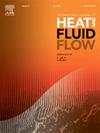Study on atomization and evaporation characteristics of liquid jets under shock wave action in supersonic flow
IF 2.6
3区 工程技术
Q2 ENGINEERING, MECHANICAL
International Journal of Heat and Fluid Flow
Pub Date : 2025-01-25
DOI:10.1016/j.ijheatfluidflow.2025.109762
引用次数: 0
Abstract
This paper focuses on investigating the impact of incident shocks on the atomization, evaporation, and diffusion characteristics of a liquid jet in supersonic flow. By adjusting the position of the shock wave generator, the interaction between the incident shock wave and the wall can be modified. The gas–liquid two-phase flow process is solved using the Euler-Lagrange method, allowing for the analysis of the atomization, evaporation, and mixing processes of kerosene. Through a thorough examination of the numerical simulation results, the underlying mechanisms by which shock waves affect the breakup and evaporation of kerosene are revealed. The findings indicate that the passage of the airflow through the incident shock wave leads to an increase in temperature and pressure. This, in turn, accelerates the evaporation process of kerosene droplets, resulting in a deeper penetration of kerosene vapor. The penetration depth can be increased by up to 39.7 %. Additionally, the decrease in airflow velocity after the shock and the formation of vortex structures in the flow field, caused by the incident shock, effectively enhance the diffusion and mixing of kerosene. These results provide valuable insights for improving the mixing characteristics of fuel atomization and evaporation, ultimately enhancing the subsequent combustion process.
求助全文
约1分钟内获得全文
求助全文
来源期刊

International Journal of Heat and Fluid Flow
工程技术-工程:机械
CiteScore
5.00
自引率
7.70%
发文量
131
审稿时长
33 days
期刊介绍:
The International Journal of Heat and Fluid Flow welcomes high-quality original contributions on experimental, computational, and physical aspects of convective heat transfer and fluid dynamics relevant to engineering or the environment, including multiphase and microscale flows.
Papers reporting the application of these disciplines to design and development, with emphasis on new technological fields, are also welcomed. Some of these new fields include microscale electronic and mechanical systems; medical and biological systems; and thermal and flow control in both the internal and external environment.
 求助内容:
求助内容: 应助结果提醒方式:
应助结果提醒方式:


